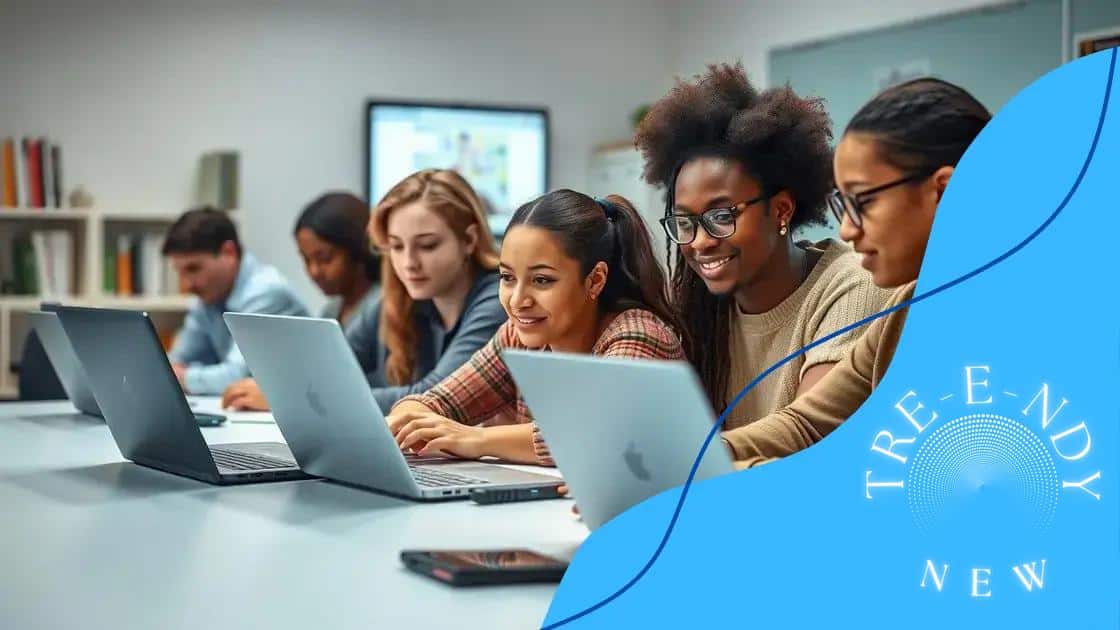The impact of virtual classrooms on student collaboration

The impact of virtual classrooms on student collaboration is profound, fostering flexibility, increased communication, and diverse perspectives while introducing challenges related to distractions and technology use.
The impact of virtual classrooms on student collaboration is a topic that resonates with many educators and students today. Have you ever wondered how these digital spaces change the way we work together? Let’s dive into how collaboration evolves in a virtual setting.
Understanding virtual classrooms
Understanding virtual classrooms is essential in today’s educational landscape. These platforms offer learners a unique environment where they can interact and engage from anywhere in the world. Virtual classrooms provide real-time lessons and collaborative opportunities, making them more flexible than traditional settings.
One significant aspect of virtual classrooms is the use of technology to facilitate learning. Students can connect via video conferencing tools, participate in discussions, and collaborate on group projects. Unlike physical classrooms, students can access resources online, enhancing their learning experience.
Features of Virtual Classrooms
Some typical features of virtual classrooms include:
- Interactive tools: Whiteboards, polls, and chat functionalities encourage student participation.
- Resource sharing: Students can access documents, videos, and other materials easily.
- Flexible scheduling: Learners can join classes from different locations and time zones.
This flexibility allows students to balance their education with other responsibilities. However, students also face unique challenges in this setting. Many miss the face-to-face interactions found in traditional classrooms. Consequently, creating a sense of community is vital for fostering connection among students. Despite these challenges, virtual classrooms empower learners to work together in innovative ways.
Advantages of Virtual Classrooms
Here are a few advantages associated with virtual classrooms:
- Accessibility: Anyone with an internet connection can access lessons.
- Diverse learning tools: Various resources can cater to different learning styles.
- Global collaboration: Students from different backgrounds can learn from and with each other.
The collaborative tools available in these classrooms enable students to participate in discussions and group work from anywhere, thus enhancing their teamwork skills and peer-to-peer learning.
As more educational institutions adopt virtual classrooms, understanding their dynamics will continue to evolve. The need for effective communication strategies and sharing platforms becomes increasingly important to ensure a productive learning atmosphere.
Benefits of virtual collaboration
Benefits of virtual collaboration are increasingly evident in modern education. Students can connect and engage with peers from all over the world, fostering a rich learning environment. One of the key advantages is the ability to share diverse perspectives.
When students collaborate in a virtual space, they benefit from various tools that enhance communication. Video calls, chat functions, and shared documents allow for seamless interaction. For instance, group projects become more manageable as students can collaborate in real-time, regardless of their physical location.
Key Advantages of Virtual Collaboration
Some important benefits include:
- Increased flexibility: Students can collaborate anytime and anywhere, making it easier to manage schedules.
- Access to global resources: Virtual collaboration opens doors to experts and knowledge beyond geographical limits.
- Enhanced teamwork skills: Working with diverse peers helps students develop important interpersonal skills.
Moreover, virtual collaboration promotes accountability among students. When working together, individuals must communicate effectively and take responsibility for their contributions. This sense of shared commitment helps students learn the value of teamwork.
Another important aspect is the creation of a supportive community. By collaborating virtually, students can build relationships with classmates from different backgrounds. These connections not only enhance their learning experiences but also prepare them for future professional environments.
As technology continues to evolve, the benefits of virtual collaboration in educational settings will likely expand. Embracing these advantages can enhance student engagement and success in the learning process.
Challenges students face in virtual settings

Challenges students face in virtual settings can hinder their learning experience. While virtual classrooms offer many benefits, they also present unique obstacles that students must navigate. Understanding these challenges is essential for creating effective learning environments.
One major challenge is the issue of distraction. In a virtual setting, students are often surrounded by many potential distractions at home, making it easier to lose focus during classes. This can lead to lower engagement and missed information.
Common Obstacles in Virtual Learning
Some common obstacles include:
- Technical difficulties: Issues such as poor internet connection or software problems can disrupt learning.
- Isolation: Lack of face-to-face interaction can make students feel disconnected and lonely.
- Self-discipline: Students may struggle with time management and motivation without the structure of a traditional classroom.
Another significant challenge is the lack of immediate feedback from instructors. In physical classrooms, students can easily ask questions and receive support. However, in a virtual setting, responses may be delayed, leading to frustration and confusion.
Additionally, some students may find it difficult to adapt to digital tools. Not everyone is familiar with the technology used in virtual classrooms, which can hinder their participation. Consequently, providing training on the necessary tools can greatly support their learning.
Finally, balancing home responsibilities with schoolwork can be overwhelming. Many students are managing family obligations, making it tough to focus solely on their studies. Being aware of these challenges will help educators devise strategies to support their students more effectively.
Tools that enhance collaboration
Tools that enhance collaboration in virtual classrooms play a critical role in making learning more effective. With the right tools, students can communicate better, share ideas seamlessly, and work together on projects easily.
One popular tool is video conferencing software. Platforms like Zoom and Microsoft Teams allow students to meet face-to-face online, making discussions more interactive. During these meetings, students can ask questions in real-time and participate actively in the learning process.
Beneficial Collaboration Tools
Several tools can significantly improve collaboration, including:
- Document sharing services: Google Docs and Microsoft OneDrive enable students to work on projects simultaneously, enhancing teamwork.
- Project management software: Tools like Trello and Asana help students organize tasks and set deadlines, ensuring everyone stays on track.
- Interactive whiteboards: Applications such as Miro allow for visual brainstorming and idea mapping, making it easier to collaborate creatively.
Using these tools, students can overcome some of the challenges of virtual learning. For instance, they can comment on each other’s work, ask for feedback, and make necessary adjustments instantly. This ongoing communication helps mimic the traditional classroom experience.
Moreover, collaboration tools create opportunities for peer-to-peer learning. When students share responsibilities in group projects, they develop a deeper understanding of the subject matter. Often, teaching one another can reinforce their knowledge and build confidence.
As educators explore new ways to enhance the virtual classroom experience, integrating effective collaboration tools will be essential. By focusing on these resources, schools can create an engaging environment that promotes teamwork and success.
Future of collaborative learning in virtual environments
The future of collaborative learning in virtual environments looks promising as technology continues to evolve. As more educational institutions adopt online platforms, collaboration will become even more integral to the learning process. This shift is changing how students interact and learn together.
One significant trend is the increased use of artificial intelligence (AI) in virtual classrooms. AI can provide personalized feedback and assessment, helping students understand their strengths and areas for improvement. As AI develops, it might facilitate better group dynamics, identifying which students work well together and suggesting collaboration opportunities.
Emerging Trends in Virtual Collaboration
Several emerging trends are shaping collaborative learning, including:
- Enhanced interaction: New tools will allow for more immersive experiences, such as virtual reality (VR) and augmented reality (AR), where students can interact in a 3D environment.
- Global classroom environments: Students from around the world can collaborate on projects, providing diverse perspectives and experiences.
- Asynchronous learning: Flexibility will continue to grow, allowing students to collaborate on their own schedules while still achieving learning objectives.
As collaborative technologies improve, students will likely enjoy more interactive sessions. These technologies encourage active participation and engagement, making learning more enjoyable. The ability to work on projects with classmates in real time can foster closer relationships and better communication skills.
Additionally, educators will increasingly seek ways to integrate cross-disciplinary learning experiences. By combining subjects, students can see how different fields connect, enhancing their understanding. This approach will promote collaboration beyond traditional boundaries, preparing students for future careers that require teamwork across various disciplines.
In this evolving landscape, adapting to new tools and methodologies will be crucial for success. Embracing the future of collaborative learning in virtual environments will empower students to thrive in an interconnected world.
FAQ – Frequently Asked Questions about Collaborative Learning in Virtual Environments
What are the main benefits of collaborative learning in virtual environments?
Collaborative learning enhances communication skills, encourages teamwork, and allows students to engage actively with diverse perspectives.
How can technology improve collaboration among students?
Technology tools like video conferencing, shared documents, and project management apps facilitate real-time collaboration, making it easier for students to work together.
What challenges do students face in virtual collaborative learning?
Students may encounter distractions, feelings of isolation, and technical difficulties that can hinder their ability to collaborate effectively.
What is the future of collaborative learning in virtual classrooms?
The future involves advancements in AI and VR, providing more engaging and interactive learning experiences that enhance student collaboration.





